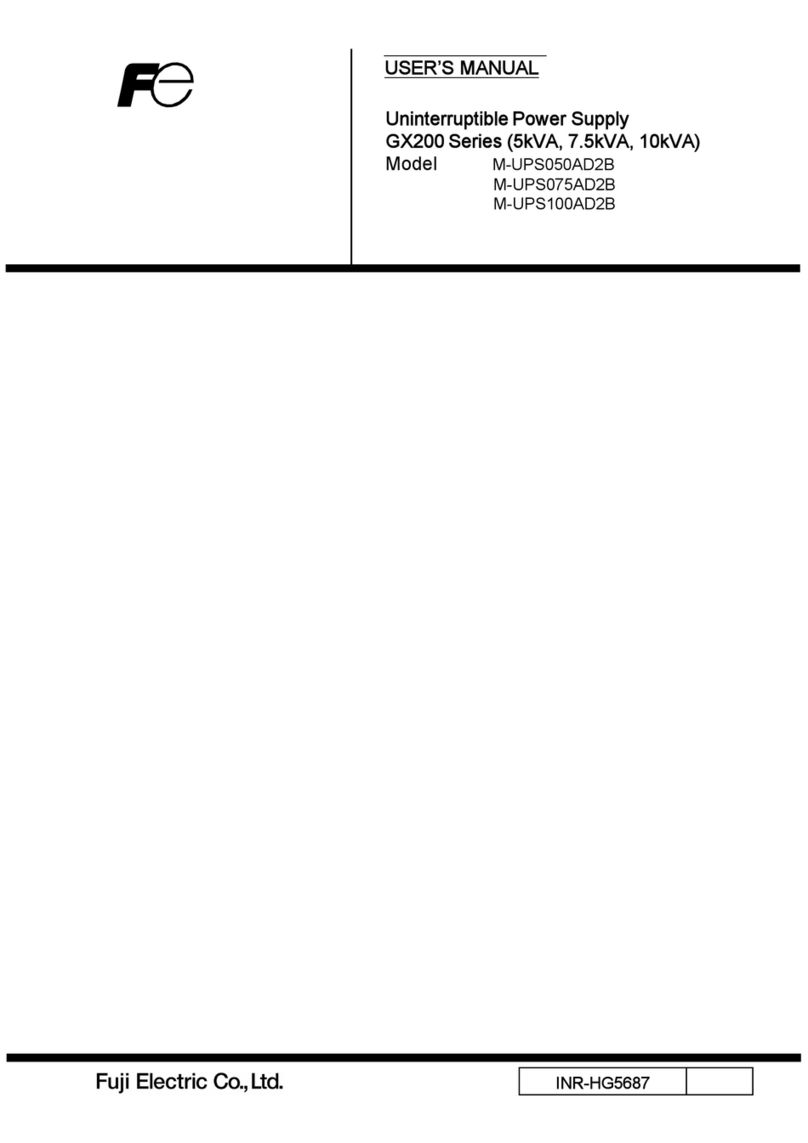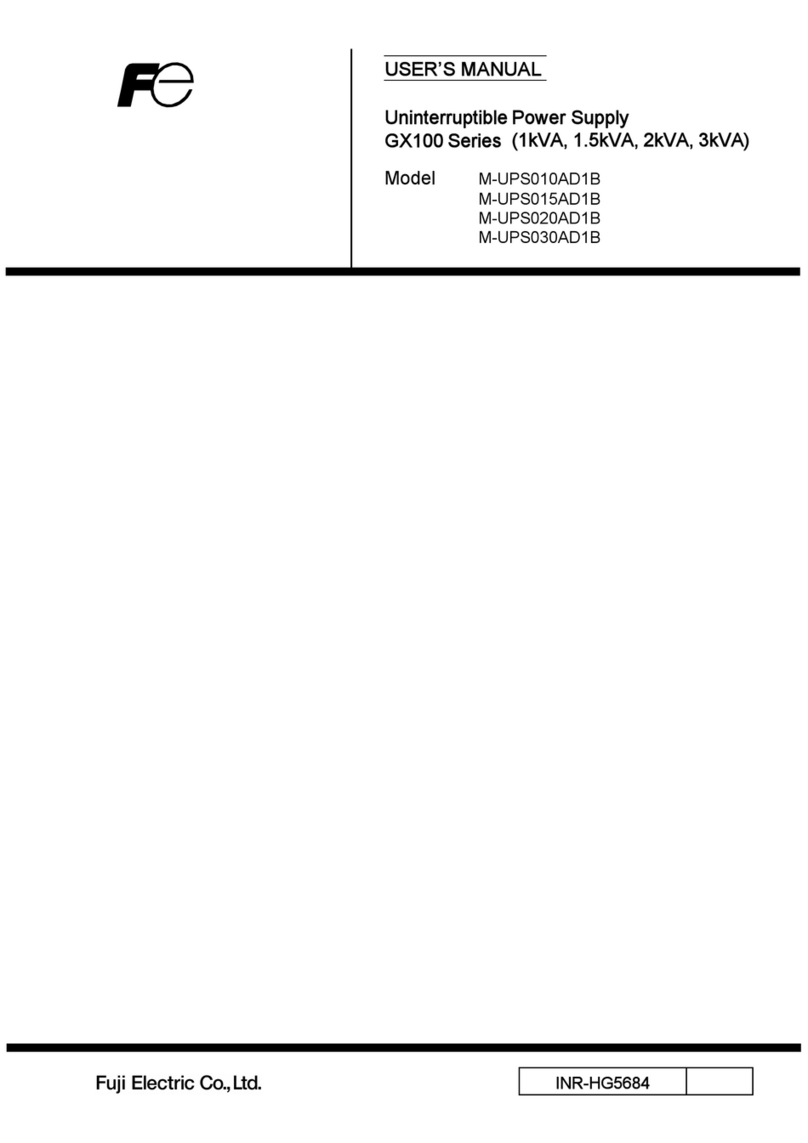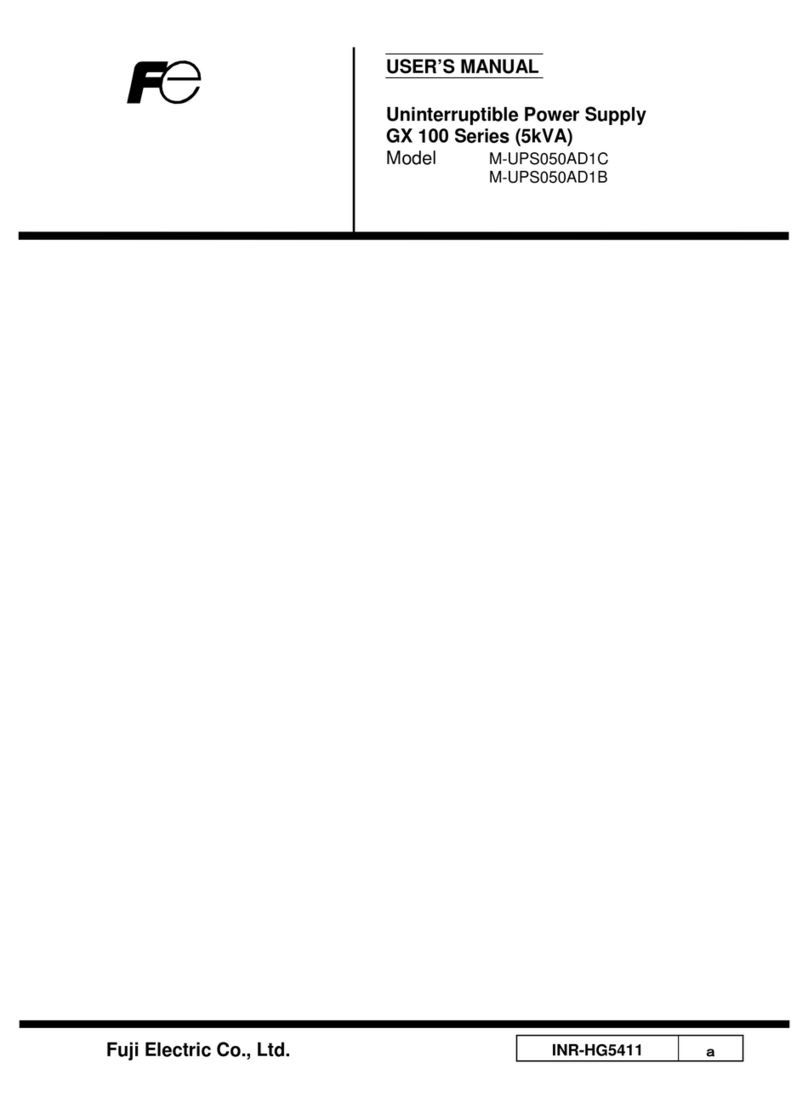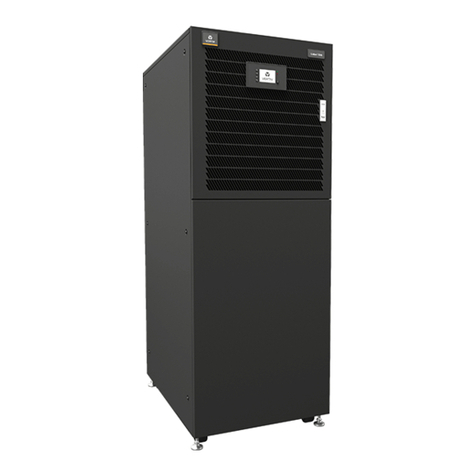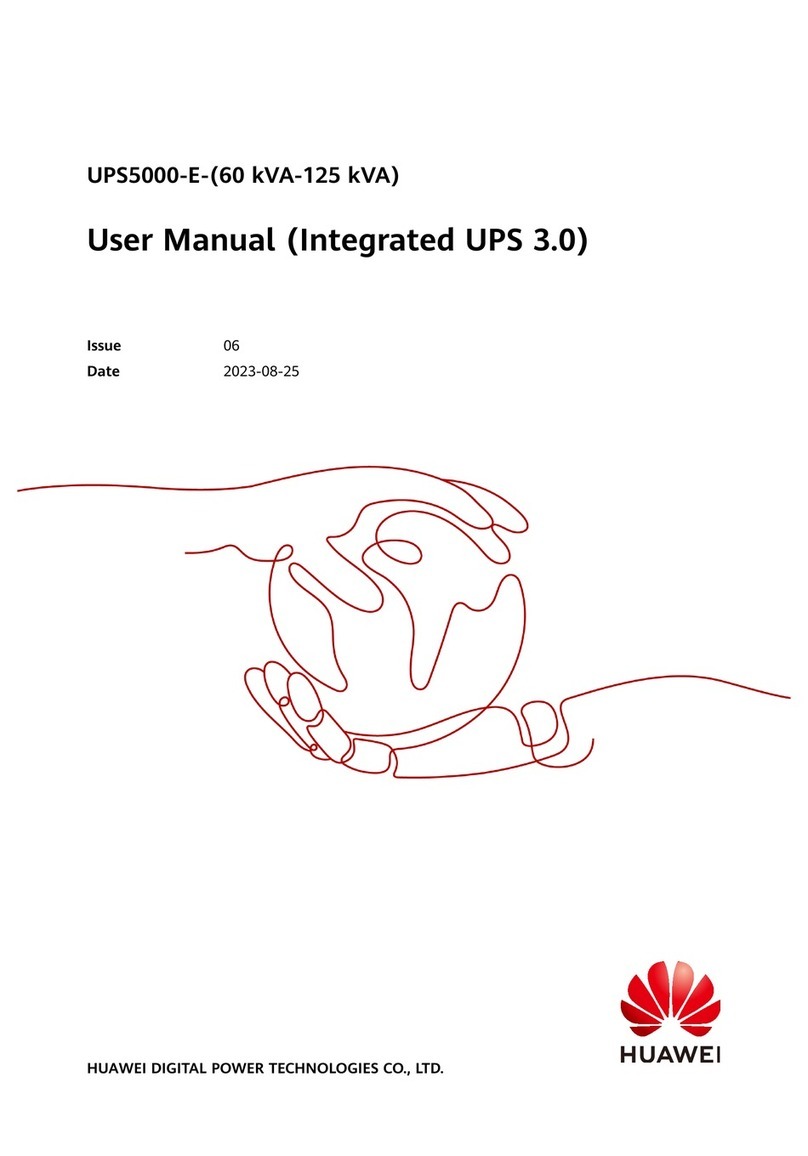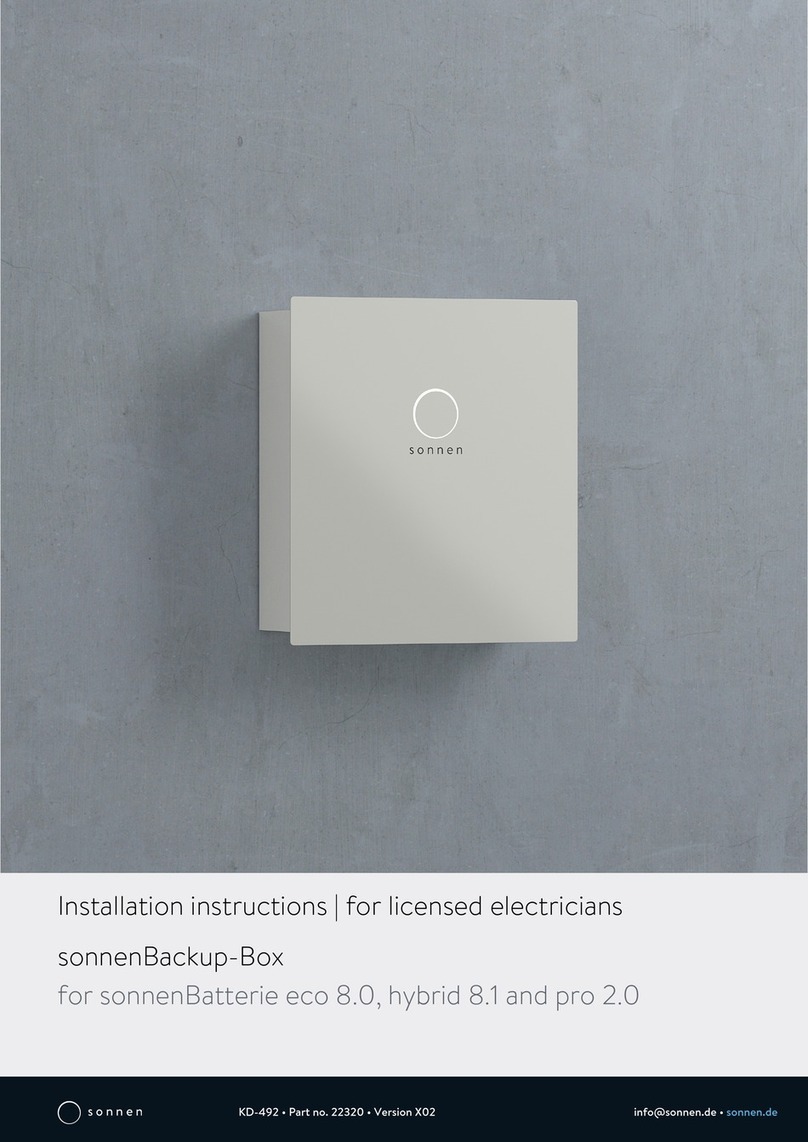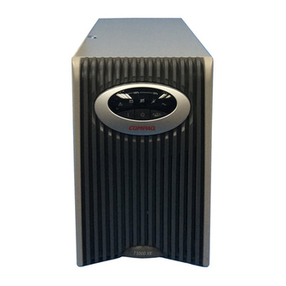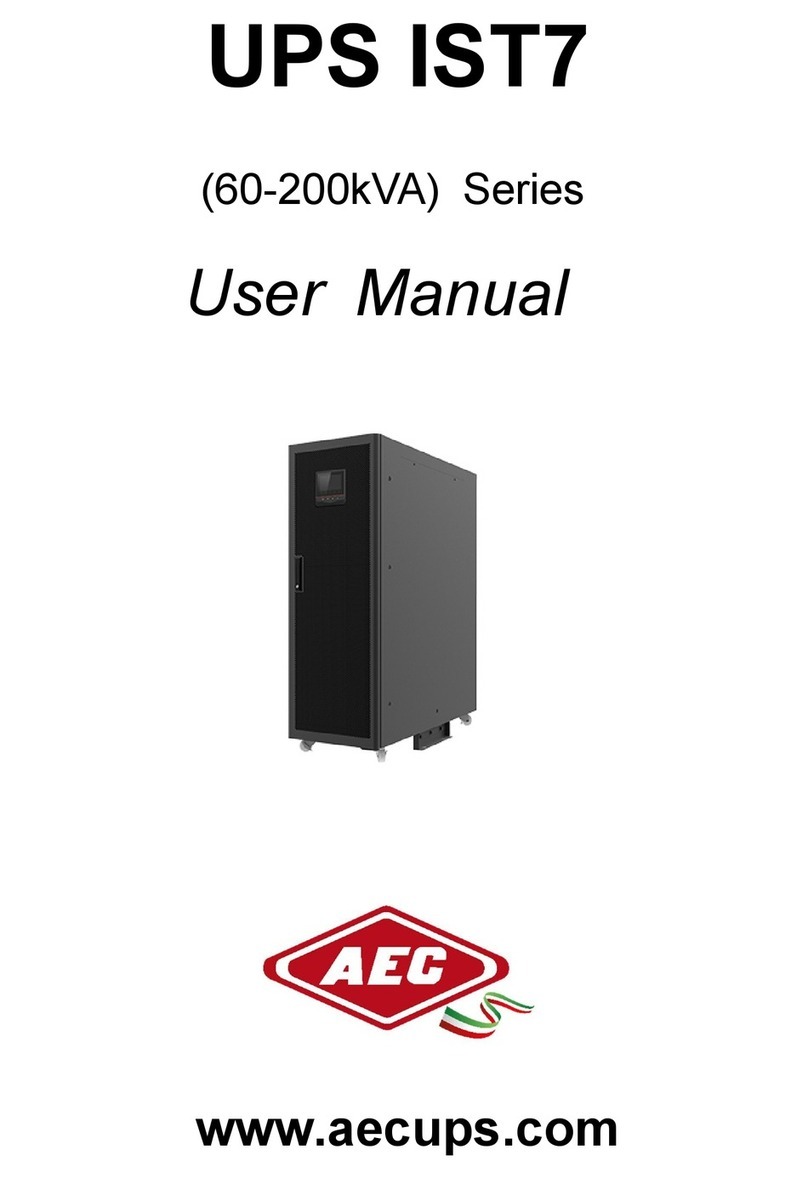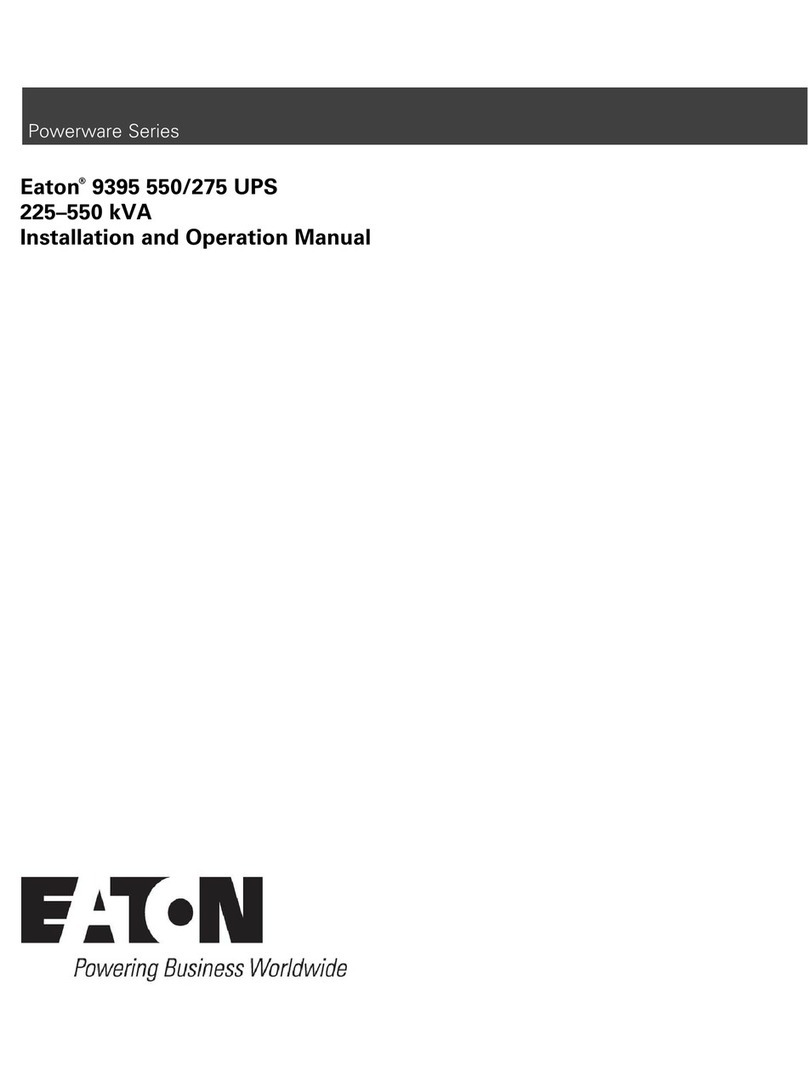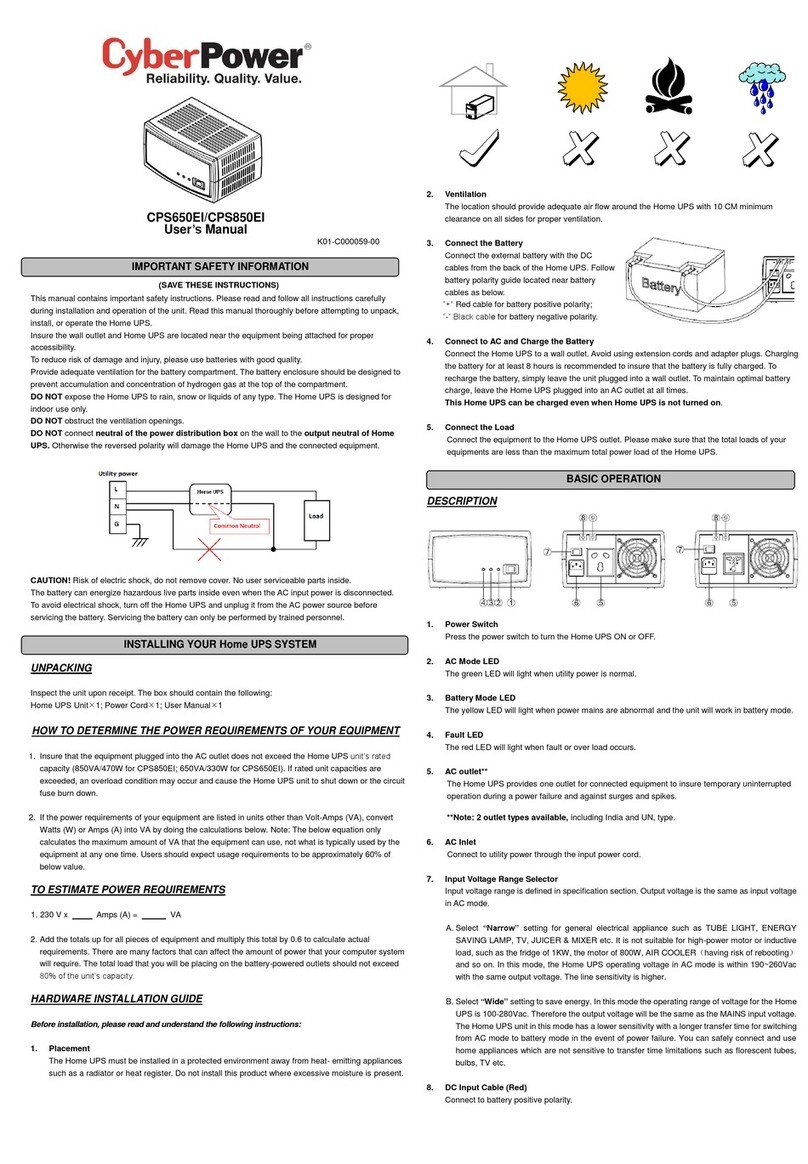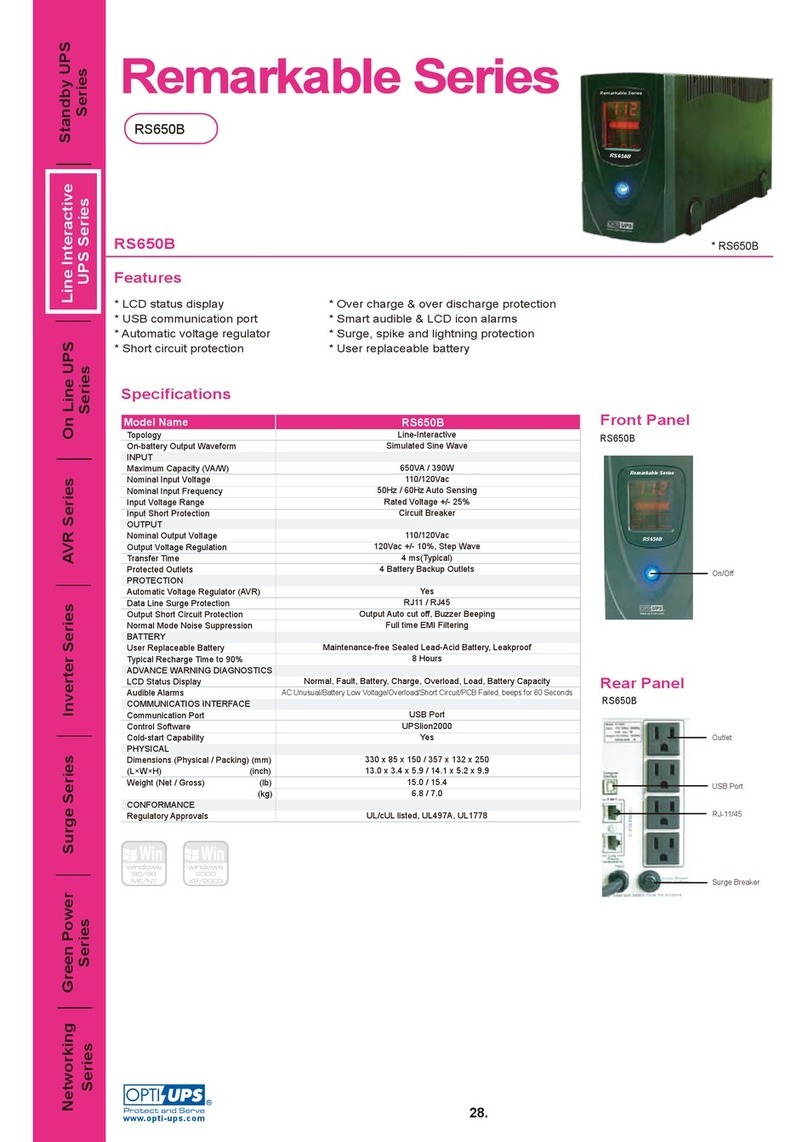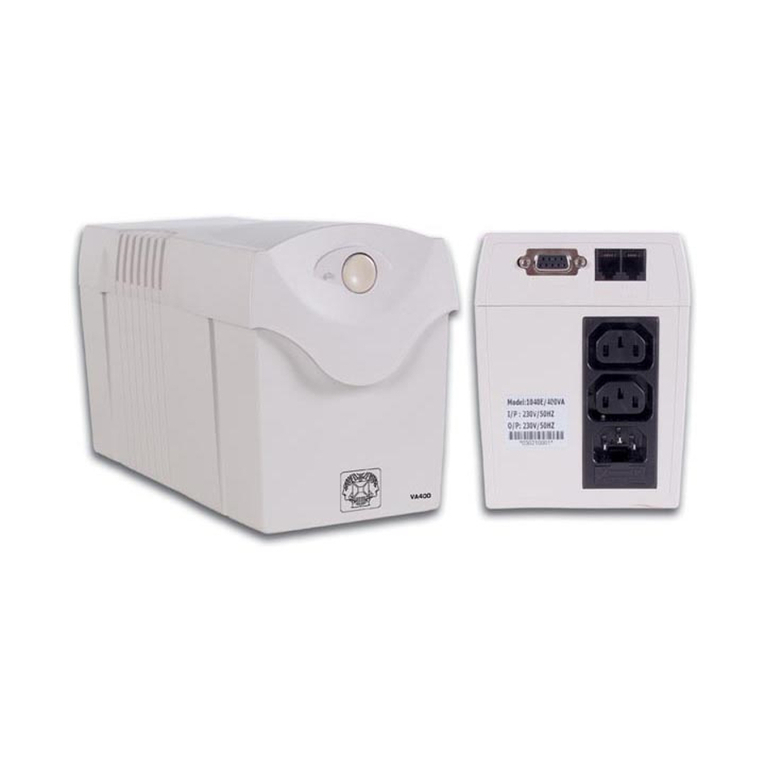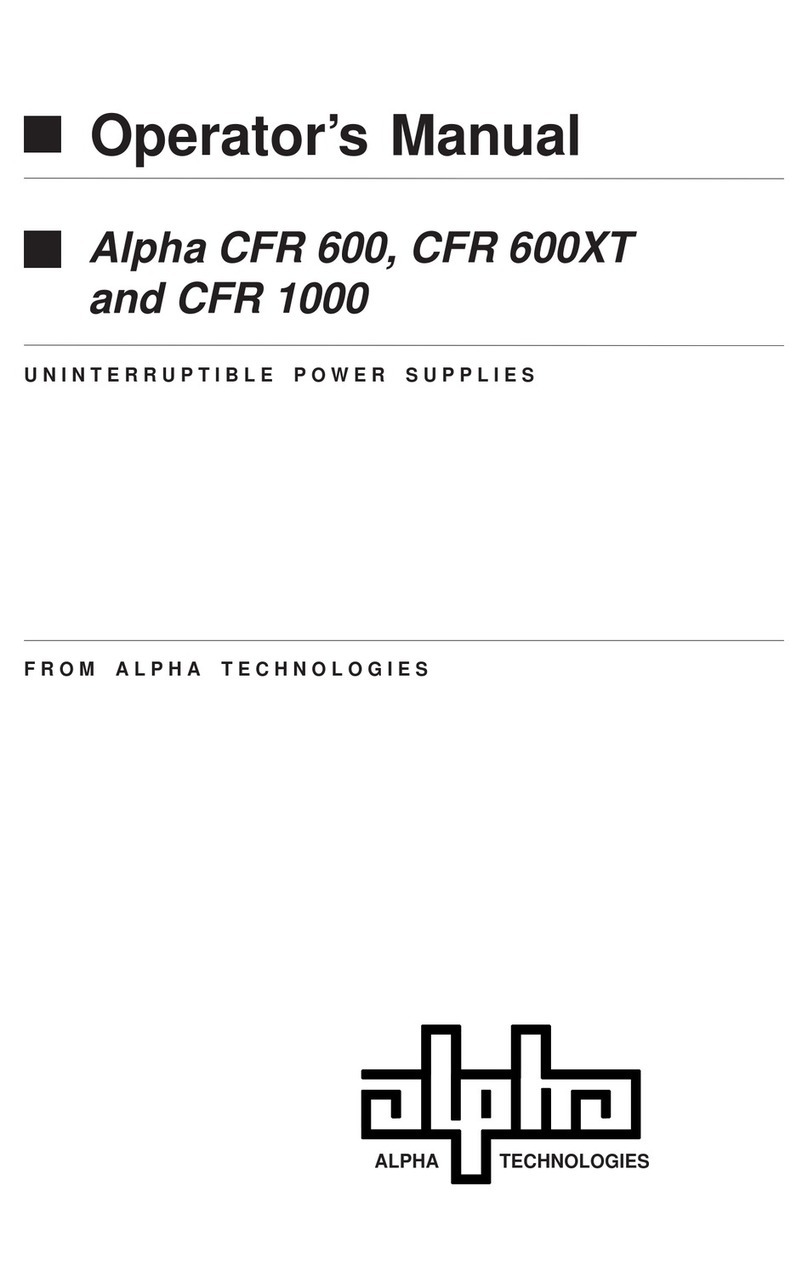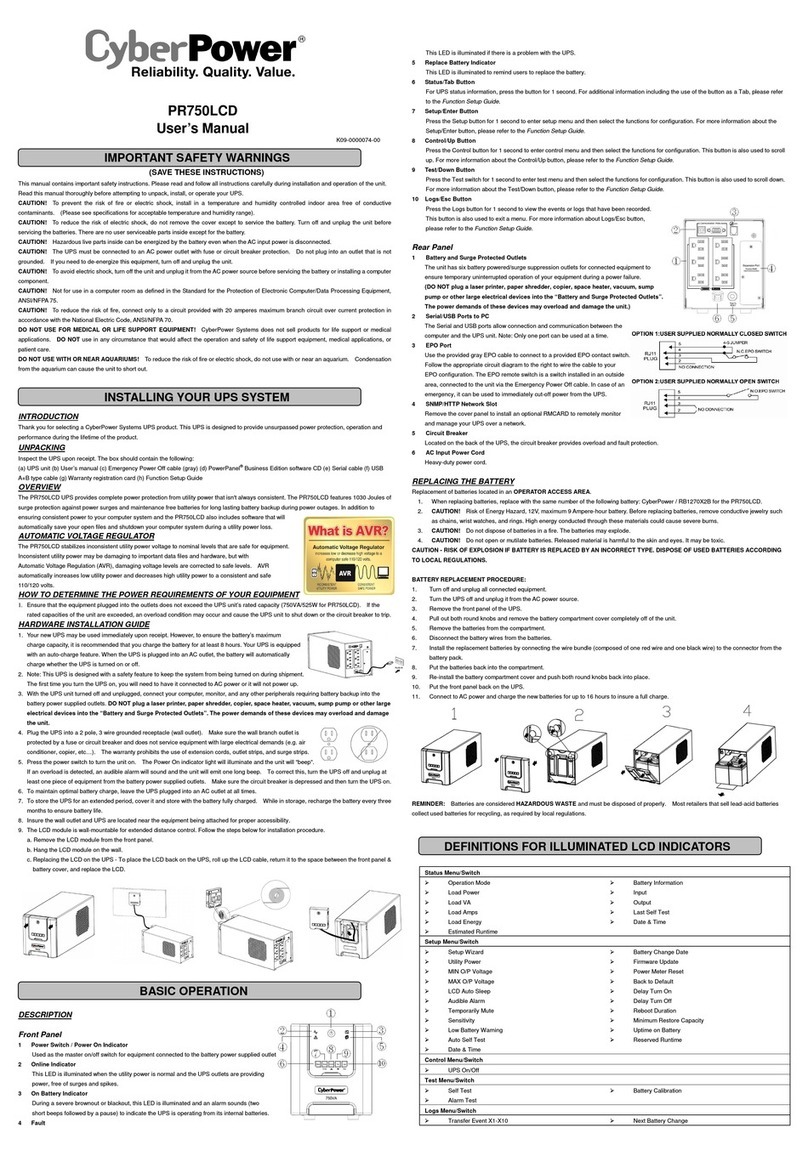FE GX100 Series User manual

USER’S MANUAL
Uninterruptible Power Supply
GX100 Series (5kVA, 7.5kVA, 10kVA)
Model M-UPS050AD1S/ M-UPS050AD2S
M-UPS075AD1S/ M-UPS075AD2S
M-UPS100AD1S/ M-UPS100AD2S
INR
-
HG5685

For safe use
Handling of this manual
This manual contains important information for safe use of the product.
Please read this instruction manual carefully before using the product to
ensure that you fully understand the product.
High-safety uses
This product is designed and manufactured for the general use, such as
general office use and personal use, and is not designed and manufactured
for uses (control of nuclear reactions at the nuclear facilities, aircraft flight
control, air traffic control, mass transport control, medical life support
systems, and missile launch control in weapon systems, etc.) that require a
high degree of safety, and can cause death or serious injury if the required
safety is not maintained. Do not use this product without carrying out
measures to ensure the required safety for such a use. If using this product
for such a use, consult with our sales representatives.
Prevention of radio interference
Important
This product is class A information technology device based on the
standards of the Voluntary Control Council for Interference by
Information Technology Equipment (VCCI). Use of this product in a
residential area may cause radio interference. In this case, the user
may be required to take appropriate action.
Prevention of Harmonic Current Interference
The product conforms to IEC61000-3-12.
All rights reserved, Copyright . Fuji Electric Co., Ltd. 2011
i

Caution about Safety
ii
Attention: Information in this manual is subject to change without notice.
Warning Indicates high risk of death or serious injuries when the
Important
Symbols
The condition of the UPS
LED Indications
Lit
Flashing
Out
Ca ution
product is not used properly.
Improper use could cause mild injuries and damage the
UPS and the connected device.
“Important” indicates caution about the use of the UPS.
Following warning signs are included to prevent the user from damaging
the UPS and the connected devices.
Warning Signs

iii
Caution about Safety
List of important warnings: Risks when UPS is not used correctly
Electric shock Do not remove the cover of the UPS.
High voltage parts inside UPS may cause electrical shock.
Electric
shock injury
Do not insert fingers or sticks into the cooling fan or the
ventilation.
Doing so may cause electric shock or injury.
Electric shock
Maintenance including the daily inspections (battery
replacement, cooling fan replacement, etc.) should be
performed by a professional technician.
Failure to do so may cause electric shock.
This UPS requires grounding (Class D grounding or
higher). When connecting to the input power supply,
connect a ground wire to the AC input protective grounding
terminal. Failure to do so may cause electric shock.
Warning
Caution Caution indicates that slight or moderate injury may occur,
the UPS or user's property may be damaged.
"Warning" indicates that death or serious injury may occur.
When connecting the UPS to the input power supply,
connect the active wire to the AC input L/R terminal and
the inactive wire to the N/S terminal. Also, connect the
ground wire to the AC input protective ground terminal.
Similarly, when connecting the output of the device,
connect the active wire to the l1/U1 terminal and l3/V1
terminal for AC output (at 100 V). For AC output (at
200V), connect to l1/U2 and l2/V2, and connect the
ground wire to the ground terminal.
Incorrect connection may cause noise, malfunction,
failure, or electric shock.
When maintaining the connected device, be sure to turn
off the power supply to the connected device. Turn off the
breaker on the distribution board and disconnect the AC
input terminals. Failure to do so may cause electric shock.
Electric shock
Failure

Caution about safety
iv
Injury Do not step on or put an object on the UPS.
Injury Damage The UPS is heavy. Caution in handling the UPS.
Take out the UPS in a level and flat place. The weight of
the UPS is as follows:
•M-UPS050AD1S/2S: 180 kg (without battery: 125 kg)
•M-UPS075AD1S/2S: 235 kg (without battery: 160 kg)
M-UPS100AD1S/2S: 300 kg (without battery: 190 kg)
This UPS is not designed for medical equipment that
comes in contact with the human body.
Do not place objects affected by magnetism near the
UPS. Replace the battery periodically. Continued use
of a UPS at the end of its battery life may result in battery
leakage or smoking.
Replace the battery with a new one specified by Fuji
Electric. Using unspecified batteries or mixing old and
new batteries may cause UPS failure or trouble.
When performing a rolling blackout, or when
unplugging the AC input plug from the input power
outlet, or when turning off the input breaker on the
rear of the UPS, make sure that the RUN LED (green)
is blinking slowly (1.6 second cycle). When the
distribution board breaker is turned off, the AC input plug
is unplugged from the input power outlet, or the input
breaker on the back of the UPS is turned off, the built-in
battery is discharged because the condition is the same
as a power failure when the RUN LED is lit. This may
cause battery deterioration and shorten the battery
replacement cycle.
Damage
Warning label
Never remove the labels.

v
Caution for use
IMPORTANT
Do not install and store the UPS in the following places:
Outdoor location
Exposed to the wind and rain
Extremely humid and dusty
With corrosive gas or salt
Direct sunlight
Near sparks or heating element
Extremely hot or cold, where the temperature fluctuates greatly
With vibration and shock
Do not perform the battery check in succession.
When the battery check is performed, the internal battery actually
discharges to check the voltage.
Consecutive battery checks may cause battery degradation and shorten
the battery replacement cycle.
If the UPS is not used for a long time, charge the battery every two
months. Charge the battery by operating the UPS for 12 hours or more
every two months. After charging the battery, perform the battery check.
If the UPS is not used for a long period of time, the battery may become
over-discharged due to self-discharge, rendering the UPS unusable.
Disposal of used battery has legal restrictions
Please follow any local, county, regional or state guidelines for the disposal
of batteries.
Do not block the vent hole and cooling fan, Do not use UPS where the
air is not well ventilated.
The UPS is equipped with vents and cooling fans to cool the inside of the
UPS; the internal and ambient temperatures of the UPS may deviate from
the rated specifications.
Replace the cooling fan periodically.
Continued use after the fan has reached the end of its service life may
cause the internal temperature of the UPS to exceed its rating.

Caution for use
vi
The allowable voltage between the UPS input electrical cable and ground is
250VAC.
Applying a voltage of 250 VAC or higher may damage the filter circuit in the input
section.
The allowable input surge voltage of this UPS is 5kV peak (1.2 x 50µs).
Applying a surge voltage exceeding 5kV peak may damage the filter circuit in the input
section.
The input voltage of the UPS is voltage 15%.
When input voltage is different from the rated voltage, install a transformer outside the
UPS to convert the voltage. Applying a voltage higher than the input voltage range
may damage UPS.
Connect the UPS to the input power supply within the rated input voltage range
of the connection device.
In bypass operation, the input voltage of the UPS is output directly to the
connection device. Applying the voltage that exceeds the rated input
voltage range of the connected device may damage the connected device.
When using a generator temporarily during a planned power outage, use a
generator that meets the following specifications.
Connecting a generator that does not meet the following specifications to the input
section of the UPS may cause the UPS to malfunction or be damaged.
Voltage variation: within 15% of rated voltage
Frequency variation: within 5% of rated frequency (1Hz per second)
Voltage waveform distortion: within 5%
Voltage zero-cross condition: No more than one zero-crossing during one cycle.

vii
Contents
Introduction ..................................................................................................................... i
1 Unpacking
1.1 Opening the package .......................................................................................... 1
Opening the package
Contents of the package
2 Overview
2.1 Name and main function of each part ........................................................... 2
2.2 How the Product Works ....................................................................................6
During normal operation
Battery power failure
Automatic bypass operation
Manual bypass operation
3 Installation
3.1 Installalling the UPS ............................................................................................. 8
Caution about installation
Determining an installation location
Installation Method
3.2 Connecting the cable.......................................................................................... 11
Caution about connecting the cable
Preparation before connection
Connecting the output cable
Connecting the input cable
3.3 Interface port ....................................................................................................... 15
CN1 (standard monitoring interface)
CN2 (PC interface)
4 Running
4.1 Turning on the UPS ..............................................................................................17
Check cable connections
Turning on the UPS
Turning on the connected device
4.2 Turning off the UPS ..............................................................................................19
Turning off the connected device
Turning off the UPS
5 Maintenance
5.1 Inspection ..............................................................................................................20
Daily Maintenance
5.2 Operation for Planned Power Outages ............................................................... 22
Operation before planned power outage
Operation after planned power outage
5.3 Inspecting the Battery .......................................................................................... 24
Checking UPS status
Using the manual check function
Charging the battery
5.4 Replacing the Battery ........................................................................................... 28
Timing of battery replacement

Contents
xiii
Method of battery replacement
Disposal and storage of battery
5.5 Replacing the Cooling Fan ................................................................................. 31
Timing of cooling fan replacement
Method of cooling fan replacement
5.6 Storing UPS ......................................................................................................... 33
UPS stored longer than two months
6 LCD Display
6.1
LED Flashing Type
Warning Sound Type
Operation mode list
Pre-Storage Operations
8 Appendix
8.1 Rated specification ................................................................................................... 53
8.2 Additional Description for UL Type ...................................................................56
How to display [Menu Indication] screen
[Menu Indication] screen
6.3 Screen operations ............................................................................................... 40
UPS Operating Condition
Warning Display screen
6.2 Details of display screens ................................................................................... 38
Overview of LCD ................................................................................................. 34
LCD screen transitions
LCD Display Contents
7 Troubleshooting
Warning Beep Sound .......................................................................................... 48
7.2 Operation Mode List ............................................................................................. 49
7.1

-1 -
1 Unpacking
1.1 Opening the package
Take out the UPS on a level and flat surface.
The mass of the Product is as follows.
M-UPS050AD1S/2S: 180 kg (125 kg without batteries)
M-UPS075AD1S/2S: 235 kg (160 kg without batteries)
M-UPS100AD1S/2S: 300 kg (190 kg without batteries)
Contents of the package
Check for any damages in the appearance of the UPS. Confirm that all
accessories are contained.
UPS Model Accessories Quantity
M-UPS050AD1S/2S
(5 kVA)
User’s manual
Fixture (with 4 lock screws)
1 copy
1 set
M-UPS075AD1S/2S
(7.5 kVA)
User’s manual
Fixture (with 4 lock screws)
1 copy
1 set
M-UPS100AD1S/2S
(10 kVA)
User’s manual
Fixture (with 4 lock screws)
1 copy
1 set
If the UPS has damages or any accessories are missing, contact the
company who you purchased the UPS from.
Cau
t
ion : Heavy Load
Opening the package

-2 -
2 Overview
2.1 Name and Main Function of Each Part
<LCD display unit>
<M-UPS050AD1S/M-UPS050AD2S>
LCD display unit

2.1 Name and Main Function of Each Part
-3 -
<M-UPS075AD1S/M-UPS075AD2S>
<M-UPS100AD1S/M-UPS100AD2S>
LCD display unit
LCD display unit

2.1 Name and Main Function of Each Part
-4 -
Name Functions
1 RUN Green light is on when the UPS is operating normally.
2 ALARM Orange light is on for any failures in the UPS.
3 OVER LOAD Orange light is on when the load capacity of the
connected device exceeds the rated specification.
4 BYPASS Orange light is on while the UPS is in bypass running.
5 BATTERY CAPACITY
6
LED
BATTERY ALARM
7 ON/OFF Press for 1 second to switch between ON and OFF
8 RESET/CANCEL
This button has 2 functions:
1) Reset the warning
Press this switch to stop the warning tone. After the fault
has been recovered, press RESET for 3 seconds to turn
off the ALARM LED.
2) Cancel the selected item on the LCD screen
Press this switch to show another item on the LCD screen.
9 BATT CHECK Press BATT CHECK button for 2 seconds
to check the battery manually.
BYPASS
To forcibly (manually) switch to bypass operation while
the UPS is in normal operation. Press switches RESET
and BATT CHECK simultaneously for 3 seconds.
Press the switches again simultaneously for 3 seconds
to return the UPS to normal operation.
10 MENU Press for LCD menu
11 SET To finalize the item selected on the LCD and go to the
sub menu.
Switch Moves the cursor upward
Switch Moves the cursor downward
Switch Moves the cursor rightward
12
Switch
Switch Moves the cursor leftward
13 LCD panel To display various operations
14 Vent hole Allows ventilation inside the UPS. The air direction is
intake.
15 Cooling fan Cools inside UPS. The air direction is exhaust.
16 Standard monitoring
interface (CN1) Outputs a no-voltage contact signal
17 PC interface (CN2) Interface for a PC
18 Input breaker Circuit breaker to protect the input circuit
Lit: 80 to 100% Flashing: 50 to 80% Out: 0 to 50%
When the battery is normal, the amount of charge is indicated.
When the battery is abnormal, it lights up orange.

2.1 Name and Main Function of Each Part
-5 -
Name Principal function
19 Connector for the
optional battery box
Connects a long-time backup battery.
20 Input/output terminal block
Connect this terminal block to the input power supply.
L/R: Ungrounded pole
N/S: Grounding side pole
Connect to load equipment.
l1/U1 l3/V1: 100V AC
l1/U2 l2/V2: 200V AC
is output.
is output.
GND (FG): Grounding terminal
21 AC input protective
grounding terminal Connect a grounding conductor to this terminal

-6 -
2.2 How the Product Works
During normal operation
This UPS operates with AC power as input and supplies constant voltage
output to connected devices. At the same time, it charges the product's
built-in battery to prepare for battery operation. The output frequency is
synchronized with the input frequency.
Electricity flow during normal operation
Battery power failure
If a power failure or input power voltage/frequency error occurs, the UPS
starts discharging from the battery and continues to supply stable power to
the connected device. The system switches to battery operation without
interruption. When the input power is restored (when the voltage of the
input power returns to within the rating), the UPS automatically returns to
the normal operation described above.
Electricity flow during battery operation
AC/AC converter
Step-up chopper
Bypass
UPS
Charger Batteries
Input power supply
: Power is fed
: Power is not fed
Output
to connected device
+
Bypass
AC/AC converter
Boost chopper
Charger Battery
[ UPS ]
Power is fed
The abnormalities
occur at an input
power supply.
While the UPS is operating,
-Power failure
-The abnormalities of voltage or frequency etc.
Power is not fed
Output
to connected device

2.2 How the Product Works
-7 -
Automatic Bypass Operation
When the abnormalities occurred in the UPS during the normal operation,
the UPS switches to the bypass operation automatically. During the
bypass operation, the UPS sends the input voltage to the output directly
and supplies the electric power to the connected device. In this case, even
if the power failure occurs, the UPS becomes the power failure state
without switching to the battery operation.
Electricity flow during automatic bypass operation
Manual bypass operation
Manual bypass operation can be switched to bypass operation during
normal operation. Press the RESET and BYPASS switches
simultaneously for 3 seconds.
Press again for 3 seconds to return to normal operation. In this case, even
if the power failure occurs, the UPS becomes the power failure state
without switching to the battery operation.
+
Bypass
AC/AC converter
BatteryCharger
[ UPS ]
Power is fed
An error
occurs inside
the UPS
The abnormalities inside the UPS
Power is not fed
Output
to connected device
Input power supply
+
Bypass
AC/AC converter
Boost chopper
Charger Battery
[ UPS ]
Power is fed
Power is not fed
Output
to connected device
Input power supply Switching to the bypass
operation manually
Electricity flow during automatic bypass operation

-8 -
3 Installation
3.1 Installing the UPS
Caution about installation
CAUTION
Injury
Damage
Installation location
IMPORTANT
Do not install and store the UPS in the following places:
Do not use in a residential area or adjacent area.
This UPS is a Class A information technology device according to VCCI
(Voluntary Control Council for Interference by Information Technology Equipment)
standards. Use of this UPS in a residential area may cause radio interference. In
this case, the user may be required to take appropriate measures.
Do not block the vent hole and cooling fan, Do not use UPS where
the air is not well ventilated.
The UPS is equipped with vents and cooling fans to cool the inside of the UPS;
the internal and ambient temperatures of the UPS may deviate from the rated
specifications.
•Outdoor
•Exposed to the wind and rain
•Extremely humid and dusty
•With corrosive gas or salt
•Direct sunlight
•Near sparks or heating element
•Extremely hot or cold, where the temperature fluctuates greatly
•With vibration and shock
Do not step on or put an object on the UPS.
Do not place magnetically sensitive objects (monitors, hard
drives, etc.) around the UPS. It may adversely affect the object.

3.1 Installing the UPS
-9 -
The following space is required for installation
•The UPS draws air in through the vents on the front of the UPS and
exhausts it through the cooling fan on the back of the UPS. A minimum
of 10 cm of space is required on the front and back of the UPS.
When performing maintenance on the UPS, a space of approximately 1 m
is required in front of and behind the UPS.
The recommended environment is as follows.
Item Recommended environment
Temperature 15 to 25C
Humidity 30 to 70% (no condensation)
Front Rear
UPS
10 cm
or more
10 cm
or more
Intake air
Exhaust
Front
UPS
Rear
Space for
maintenance of
cooling fan
Space for
maintenance of
cooling fan/batteries

-10 -
Installation Position
CAUTION
Injury
Damage
Take out the UPS in a level and flat surface. Be
cautious to prevent accidents such as tipping over or
dropping.
The weight of the UPS is as follows:
M-UPS050AD1S/2S: 180 kg (without battery: 125 kg)
M-UPS075AD1S/2S: 235 kg (without battery: 160 kg)
M-UPS100AD1S/2S: 300 kg (without battery: 190 kg)
This UPS may only be used in a vertical position and not to be used in
a tilted position. After installation, be sure to lock the casters to
prevent displacement of the product. The casters on the front side
have locks on both the left and right sides.
When using the L-shaped fixture to secure the main unit of this product
to the floor, first secure the fixture to the floor, then secure this
product. This L-shaped fixture is intended for preventing an overturn
of the UPS.
3.1 Installing the UPS

- 11 -
3.2 Connecting the cable
Caution about connecting the cable
CAUTION
Electric
shock
Connect an AC input plug to a grounded power outlet, or connect
the ground wire to the ground terminal. (class D grounding)
Risk of an electric shock.
When connecting this product to the input power line, connect a
grounding conductor to the AC input protective ground terminal of
this product.
IMPORTANT
The allowable voltage between the UPS input cable and ground is
250VAC. Applying a voltage of 250VAC or more may damage the filter
circuit in the input section.
The allowable input surge voltage of the UPS is 5kVpeak (1.2 50
sec).
If a surge voltage of 5kV peak or more is applied, the filter circuit in
the input section may be damaged.
The input voltage to this product is 15% of the rated voltage.
If the input voltage is different from the rated voltage, install a
transformer for voltage conversion outside of this product. If a voltage
outside the input voltage range is applied, the product may be damaged.
The input voltage to the product must not exceed the rated input
voltage range of the connected equipment.
During bypass operation, the input voltage to the product is output as it
is. If a voltage exceeding the rated input voltage range of the
connected device is applied, the connected device may be damaged.
Other manuals for GX100 Series
1
This manual suits for next models
6
Table of contents
Other FE UPS manuals
Popular UPS manuals by other brands

Riello
Riello Sentinel Dual SDH 1000 Installation and use manual
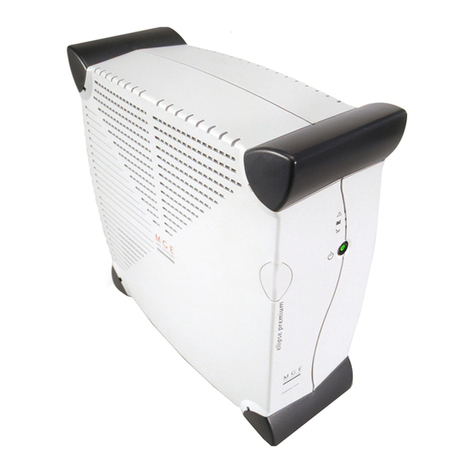
MGE UPS Systems
MGE UPS Systems Pulsar ellipse 1200 Installation and user manual
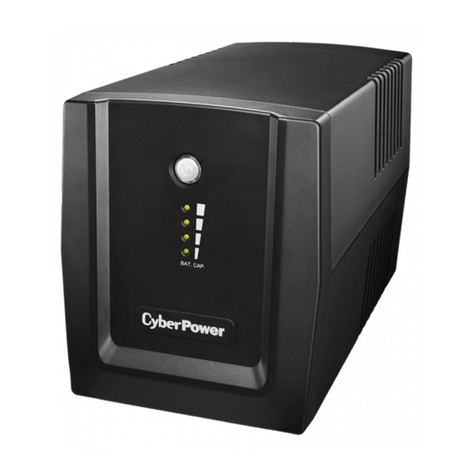
CyberPower
CyberPower UT1500 user manual
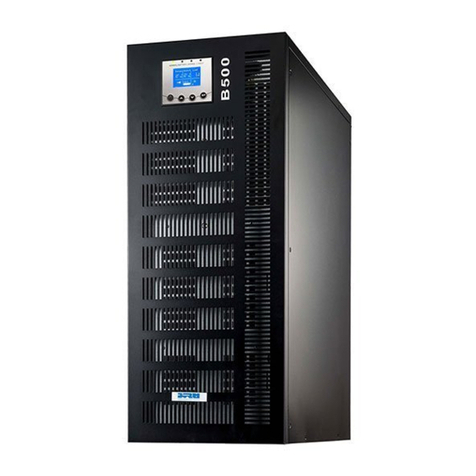
Borri
Borri B500EVO-100-B user manual
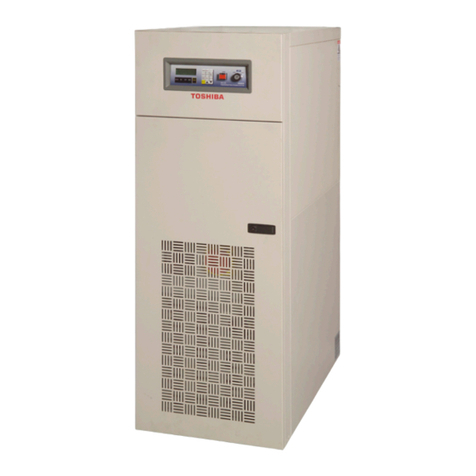
Toshiba
Toshiba 4200FA Series Installation and operation manual
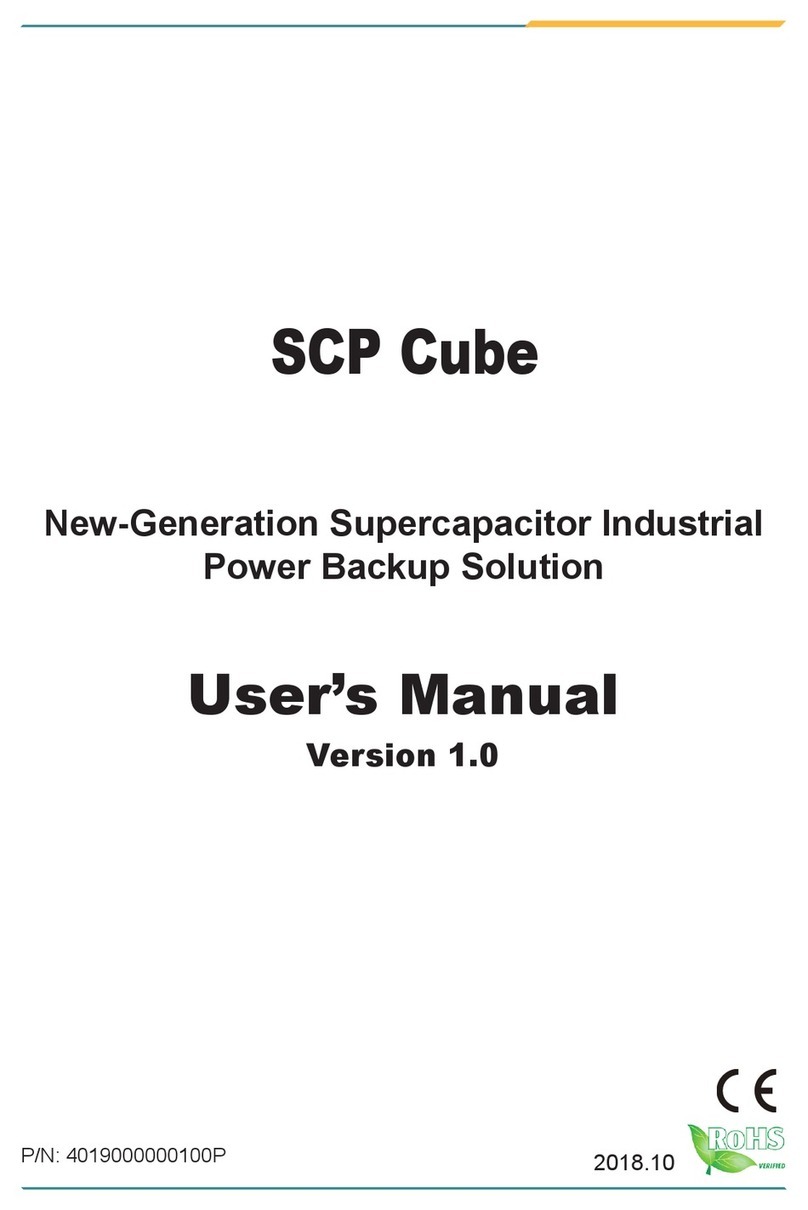
Arbor Technology
Arbor Technology SCP Cube user manual
